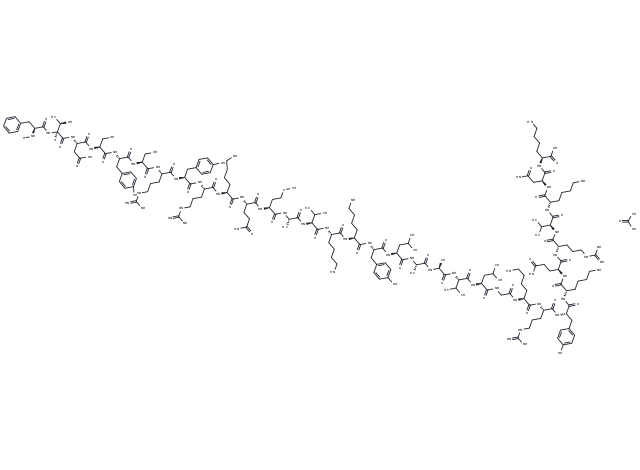Shopping Cart
Remove All Your shopping cart is currently empty
Your shopping cart is currently empty
PACAP (6-38), human, ovine, rat acetate is a potent PACAP receptor antagonist with IC50s of 30, 600, and 40 nM for PACAP type I receptor, PACAP type II receptor VIP1, and PACAP type II receptor VIP2, respectively.

| Pack Size | Price | USA Warehouse | Global Warehouse | Quantity |
|---|---|---|---|---|
| 1 mg | $89 | - | In Stock | |
| 5 mg | $262 | - | In Stock | |
| 10 mg | $351 | - | In Stock | |
| 25 mg | $562 | - | In Stock | |
| 50 mg | $762 | - | In Stock | |
| 100 mg | $1,030 | - | In Stock | |
| 200 mg | $1,390 | - | In Stock |
| Description | PACAP (6-38), human, ovine, rat acetate is a potent PACAP receptor antagonist with IC50s of 30, 600, and 40 nM for PACAP type I receptor, PACAP type II receptor VIP1, and PACAP type II receptor VIP2, respectively. |
| In vitro | An increase of dopamine (DA) content by HPLC analysis and/or cell proliferation identified by MTT assay by Dexamethasone (DEX) is also observed which can be inhibited by PACAP (6-38) at concentration sufficient to block PACAP type 1 (PAC1) receptor. Pretreatment with PACAP (6-38) at 0.1 or 1 μM for 2 h significantly blocks this increase of DA content by 1 μM DEX. The MTT assay shows that DEX increases cell proliferation. Moreover, this action is also inhibited by the pre-incubation of PACAP (6-38). PACAP (6-38) at 1μM shows no effect on DA content and cell proliferation for 24 h. However, PACAP (6-38) at 0.3 μM has been mentioned to reduce the spontaneous tyrosine hydroxylase (TH) accumulation in differentiated retinal cultured cells for 5 days[2]. |
| In vivo | Intravesical administration of PACAP (6-38) (300 nM) significantly (p≤0.01) increases intercontraction interval (2.0-fold) and void volume (2.5-fold) in NGF-OE mice. Intravesical instillation of PACAP (6-38) also decreases baseline bladder pressure in NGF-OE mice. Intravesical administration of PACAP (6-38) (300 nM) significantly (p≤0.01) reduces pelvic sensitivity in NGF-OE mice but is without effect in WT mice[3]. |
| Molecular Weight | 4085.84 |
| Formula | C184H303N55O48S |
| Smiles | [H]N[C@@H](CC1=CC=CC=C1)C(N[C@]([H])(C(N[C@@H](CC(O)=O)C(N[C@H](C(N[C@@H](CC2=CC=C(C=C2)O)C(N[C@H](C(N[C@H](C(N[C@@H](CC3=CC=C(C=C3)O)C(N[C@H](C(N[C@H](C(N[C@H](C(N[C@@H](CCSC)C(N[C@@H](C)C(N[C@H](C(N[C@H](C(N[C@H](C(N[C@@H](CC4=CC=C(C=C4)O)C(N[C@H](C(N[C@@H](C)C(N[C@@H](C)C(N[C@H](C(N[C@H](C(NCC(N[C@H](C(N[C@H](C(N[C@@H](CC5=CC=C(C=C5)O)C(N[C@H](C(N[C@H](C(N[C@H](C(N[C@H](C(N[C@H](C(N[C@H](C(N[C@H](C(O)=O)CCCCN)=O)CC(N)=O)=O)CCCCN)=O)C(C)C)=O)CCCNC(N)=N)=O)CCC(N)=O)=O)CCCCN)=O)=O)CCCNC(N)=N)=O)CCCCN)=O)=O)CC(C)C)=O)C(C)C)=O)=O)=O)CC(C)C)=O)=O)CCCCN)=O)CCCCN)=O)C(C)C)=O)=O)=O)CCC(N)=O)=O)CCCCN)=O)CCCNC(N)=N)=O)=O)CCCNC(N)=N)=O)CO)=O)=O)CO)=O)=O)[C@H](O)C)=O.CC(O)=O |
| Relative Density. | no data available |
| Sequence | Phe-Thr-Asp-Ser-Tyr-Ser-Arg-Tyr-Arg-Lys-Gln-Met-Ala-Val-Lys-Lys-Tyr-Leu-Ala-Ala-Val-Leu-Gly-Lys-Arg-Tyr-Lys-Gln-Arg-Val-Lys-Asn-Lys-NH2 |
| Sequence Short | FTDSYSRYRKQMAVKKYLAAVLGKRYKQRVKNK-NH2 |
| Storage | store at low temperature,keep away from moisture | Powder: -20°C for 3 years | In solvent: -80°C for 1 year | Shipping with blue ice/Shipping at ambient temperature. | ||||||||||||||||||||
| Solubility Information | H2O: 50 mg/mL (12.24 mM), Sonication is recommended. | ||||||||||||||||||||
Solution Preparation Table | |||||||||||||||||||||
H2O
| |||||||||||||||||||||
| Size | Quantity | Unit Price | Amount | Operation |
|---|

Copyright © 2015-2025 TargetMol Chemicals Inc. All Rights Reserved.